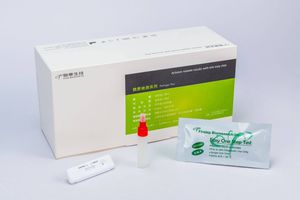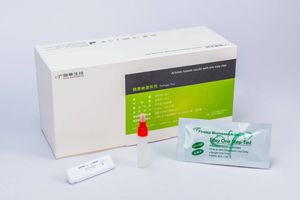
- Laboratory
- Laboratory medicine
- Rapid Helicobacter pylori test
- Firstep Bioresearch, Inc.
Rapid gastrointestinal infection test P031-Cfor antigensHelicobacter pylorifeces
Add to favorites
Compare this product
Characteristics
- Applications
- for gastrointestinal infections
- Tested parameter
- for antigens
- Micro-organism
- Helicobacter pylori
- Sample type
- feces
- Analysis mode
- immunochromatographic
- Result display time
10 min
Description
Helicobacter pylori is a corkscrew-shaped, gram-negative rod that lives in the mucous layer of the stomach. H. pylori infection is now accepted as the most common cause of gastritis, and is etiologically involved in gastric ulcer, duodenal ulcer, gastric adenocarcinoma and primary gastric B-cell lymphoma. The organism is very common, infected at least half of the world’s population. H. pylori infection is typically acquired in childhood. Once acquired, infection persists chronically, probably continuing in the stomach throughout life. The diagnostic tests for H. pylori can be classified into two categories: Invasive and Noninvasive tests.
Direct detection by invasive test procedures requires an endoscopy and biopsy specimens from antrum and stomach body. Although the procedure is highly specific and high positive predictive value, the cost and discomfort to the patients are very high.
The most widely available noninvasive test is probably the serological based test. The serology test detects H. pylori specific IgG antibody in patient serum with current or prior infection. Serology test is a simple, convenient test with relative high sensitivity. The main limitation of serology test is the inability to distinguish current and past infections. Antibody may be present in the patient’s serum long after eradication of the organism.
The urease breath test (UBT) with 14C or 13C labeled urea, is a noninvasive test based on the urease activity of the organism and is highly sensitive and specific.The UBT requires a high density
Catalogs
No catalogs are available for this product.
See all of Firstep Bioresearch, Inc.‘s catalogsOther Firstep Bioresearch, Inc. products
PATHOGEN DETECTION RAPID TEST
Related Searches
- Blood rapid diagnostic test
- Rapid lateral flow test
- Immunoassay rapid diagnostic test
- Cassette rapid diagnostic test
- Rapid virus test
- Serum rapid diagnostic test
- Plasma rapid diagnostic test
- Infectious disease rapid diagnostic test
- Whole blood rapid diagnostic test
- Urine rapid diagnostic test
- Bacteria rapid diagnostic test
- Strip rapid diagnostic test
- Rapid feces test
- Rapid drug abuse test
- Clinical rapid diagnostic test
- Nasopharyngeal rapid diagnostic test
- Obstetrical/gynecological rapid test
- Pregnancy rapid diagnostic test
- Rapid cardiovascular disease test
- HCG rapid diagnostic test
*Prices are pre-tax. They exclude delivery charges and customs duties and do not include additional charges for installation or activation options. Prices are indicative only and may vary by country, with changes to the cost of raw materials and exchange rates.



